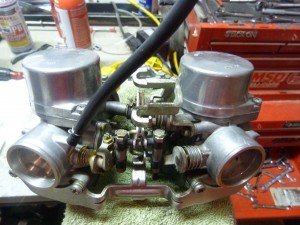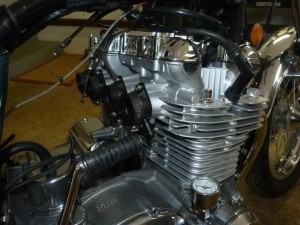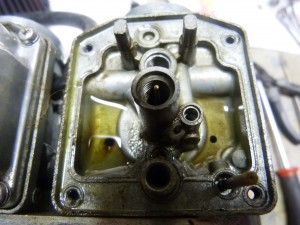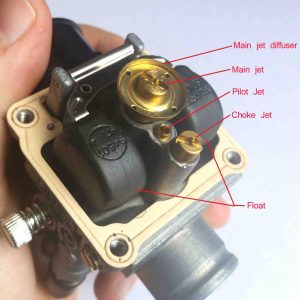Normally, my old bikes start right up – even if I haven’t started them in awhile. This latter being a regular thing during the winter months, when riding a motorcycle is either not possible (snow-ice and single track vehicles don’t mix well) or just miserable, due to the cold and the lack (in my case) of a heated riding suit.
But sometimes, one of them won’t start – or is hard-to-start. This happens – eventually – with any machine, whether used irregularly or regularly. Regular use results in wear, which – eventually – leads to something wearing out. Irregular use can lead to something not working, which amounts to the same thing.
It won’t start – or it’s hard-to-start.
The difference, old-vs.-modern machine, is that the old stuff was almost entirely mechanical, with few electrical things that could go wrong and even those were easy enough to diagnose and repair. For instance, when my ’83 Honda wouldn’t start for the trip back home from my buddy’s shop a month or so ago, it was easy enough to diagnose (with a multimeter) a dead battery and then that the new battery wasn’t being charged – and that the bike needed a new rectifier. It took a couple of minutes to install a new one and then the bike started right up.
It has been hard-to-start other times as well. Every time, it’s been because the carburetors needed cleaning and/or so did the plugs, which have to be cleaned (or replaced) more often when a machine is fed fuel via carburetor(s) because these mechanical fuel-mixers do not ration the air-fuel mix as precisely and finely as electronic fuel injection does. Carburetors sometimes feed the engine a bit more gas than is ideal – this is called a “rich” air-fuel mixture – and that tends to result in carbon building up on the spark plugs, resulting in them not firing as well – and the engine not starting as easily (if it starts at all).
The carb(s) can also get gunked-up with the residue-result of fuel chemically degrading/interacting with carburetor parts, such as rubber/plastic parts. Inside a carburetor, there is a bowl – which is filled with liquid gas, just sitting there. The gas is not in a sealed container – and we all know what happens when gas is left in an unsealed container for say several months at a time. This is a much-lesser-issue with EFI because the fuel circuit in EFI is sealed – and because there isn’t a bowl of liquid gas just sitting there, gradually decomposing.
But, when something does go awry with the EFI, there is generally little you can do about it. In part because few of us know what to do about it. Or can know. Not without the necessary diagnostic equipment, which in some cases costs more than the vehicle. And which in most cases, most of us wouldn’t know how to use, regardless. You marvel at the black box – knowing the genie within is unhappy but not knowing how to make him happy.
It’s different with the old stuff. The mechanical stuff. You can see what might be wrong. It’s a visual-physical process of diagnostics. Is the carb gunked up? It’s easy to tell. Just inspect it. If it is, just clean it (or them, as the case may be). This latter is something almost anyone can do who is willing to do it.
Almost anyone can understand it, at any rate.
Four screws (typically) hold the fuel bowl to the carburetor – if it’s a motorcycle carburetor. Remove them and you have the bowl in hand. How does it look? Is the gas yellowish? Is there sludge in the bottom of the bowl? If you’ve found either, you’ve probably found your problem. Clean the bowl – with carburetor cleaner – and maybe dump the going-bad-gas you left to sit in the tank for too long.
You may need to go a little deeper into the carb(s) and clean the orifices – jets and such – through which the gas must freely flow. But once again, you can see (and handle) all of these mechanical – these physical – parts and that makes seeing what’s wrong a lot easier than wondering what’s wrong within the black box, the computer that runs the EFI as well as many other things besides.
When my laptop computer stopped working, the only thing I could do about it was take it to the computer store, where the technicians understand the workings of things that cannot be seen or handled and which operate on principles opaque to the understanding of Neanderthals such as myself.
And that’s why I ride bikes that are mechanical things rather than electronic things. They may not start sometimes.
But when they don’t, I can usually get them running again.
That works for me.
Literally!
. . .
Got a question about cars, Libertarian politics – or anything else? Click on the “ask Eric” link and send ’em in! Or email me at EPeters952@yahoo.com if the @!** “ask Eric” button doesn’t work!
If you like what you’ve found here please consider supporting EPautos.
We depend on you to keep the wheels turning!
Our donate button is here.
If you prefer not to use PayPal, our mailing address is:
EPautos
721 Hummingbird Lane SE
Copper Hill, VA 24079
PS: Get an EPautos magnet or sticker or coaster in return for a $20 or more one-time donation or a $10 or more monthly recurring donation. (Please be sure to tell us you want a magnet or sticker or coaster – and also, provide an address, so we know where to mail the thing!)
My eBook about car buying (new and used) is also available for your favorite price – free! Click here. If that fails, email me at EPeters952@yahoo.com and I will send you a copy directly!












I could only think of this scene in weird al’s movie UHF, when I read the title of this article. It fits well too.
https://youtu.be/hXOjyv4d998
When I was growing up, our family had 5 Ford Pintos and a Chevy Chevette in the driveway – and these carburated cars had starting issues when it was cold and wet. I found out that if automatic choke failed or the preheater on the air intake, you will have problems. i have a old Dodge Power Wagon with a manual choke, which is fantastic. Simple. You just taper the choke as the engine warms. I like how i interact with the engine, it takes finesse.
My Geo Metro has EFI, but only a single injector, pointed down, right where the carburetor used to be. To check it you remove the air cleaner assembly and hook up the timing light and aim the light down the throat with the engine running. It the injector is not fouled and the pressure is correct, you will see a cone of spray. On the metro, the injector actually sprays 90 degrees sideways but the airflow makes it look like a cone.
It is easy to diagnose compared to other EFI vehicles I have owned, with one injector per cylinder and an additional cold start injector – which sprays for 3 minutes on a cold start. It has a timer. So if you do a cold start and stop the engine then restart it you may have trouble. i had some mid 1980s Toyota vans that would do this, it took me forever to figure it out, and this flaw was not in any operator or repair manual.
There’s no manual fuel enricher for a cold start on EFI engines. You can pump the gas pedal all you want and it will not richen the fuel, the computer does it automatically based on temperature. When cold, the normal idle fuel flow rate is tripled then it falls off in a couple of minutes, as shown in this chart:
https://metrompg.com/zoom_image.htm?H=349&W=496&ZoomFile=chart%2Dwarmup%2Dz%2Egif&Caption=&title=warm%2Dup%20graph##
https://metrompg.com/posts/warm-up-idling.htm
The Geo Metro (Canadian Firefly) burns 1.5 liter/hour on a cold start then that tapers off to 0.5 liters per hour. That means if you just idle the engine it will burn about a gallon in 8 hours.
If you have any OBD2 car, built 1996 onward, you can buy a computer reader and see all the details of fuel flow for your car.
The injector is very simple, it is a solenoid – it opens when you put 12 volts to it. the computer sends a split second voltage to it, it opens, pressurized fuel is then released in a spray, to atomized the fuel on the way to the pistons. Over the years I noticed the distance between the injector to the pistons has changed as cars changed how EFI was incorporated. I think they have direct injection now.
it’s been a mixed bag of all the cars I’ve owned of old school carburated vs. injector EFI. I have found that if you keep your modern EFI car to factory spec, it will be very reliable. The biggest flaw with new engines is the el cheapo timing belt, which can snap. Timing chains are more reliable, but when they stretch with age they cause weird stalling problems as the timing changes when the engine heats up.
So after decades of slaving away on many cars I got wise, keep the engine in good working order, replace parts as the factory manual specifies. The Geo Metro is an extremely simple car, which is the way a car should be, IMO at least. It do not want to own something i can not fix myself. I like the idea of hybrids, but i do not want to work on one.
The Geo Metro has a very simple fuel delivery system, and only one injector (TBI), so that is easy to diagnose. I will tell you the only reason anyone would want a Metro, the extreme fuel economy, at highway speeds it only burns one gallon per hour. And no it is not fun to drive, you are just glad to get where you are going without costing a fortune. Out here in Oregon i paid $5.50 a gallon unleaded all summer and fall.
I had a Renault 12 back in the day. After sitting over a weekend at the campsite it wouldn’t start. Wiping the distributor cap with kitchen towel got her going again.
Who knows what a distributor was nowadays?
Ford Recalls 519,000 Broncos And Escapes Over Cracked Fuel Injectors Sparking Engine Fires
3 cylinder bronco….lol
high tech direct injection grief….lol….injectors probably made in china…
https://www.zerohedge.com/markets/ford-recalls-519000-broncos-and-escapes-over-cracked-fuel-injectors-sparking-engine-fires
from zh comments….
Recently here heard a story about a local Guy who bought a Brand New King Ranch F250 4X4
( Guess it was about $90k )
Had almost every single major everything FAIL in it…In just a few months, problems with
The Engine, Transmission, 4X4 System, Emissions, Electrical…almost everything.
What a Piece of Crap…He’d get it back from the dealer to fix one thing & LOL it would break down before he got home
I have a friend that bought a 2022 GM product truck that is in the shop more than in his garage. He paid 78k.
My sister had a brand new Kia that burned a quart of oil a month. The dealership did a test on her car and told her that it’s normal.
The American automobile industry, like many others, died slowly about 30 years ago. Labor, production outsourcing, asset stripping and financialization were the mortal wounds to it.
My Scion TC burns a quart of oil per 1000 miles. I drive it less than 1000 miles per month, so less frequently than your sister. Toyota also told me that it is normal. In contrast, my 72 Chevelle and 98 Ranger didn’t burn that much oil in the 34 years I drove them.
My 2002 Civic didn’t burn a drop between each 12 month service!
Robert,
It did burn a “drop” of oil between service intervals, just not a measurable drop on your dipstick. I have not owned but one car in the last twenty years that burned more than that. An 02 Impreza, and it and I parted company quickly.
“That’s normal” is the legal way to get out of honoring the warranty. It’s long been an established given that when an engine starts burning a quart of erl in 3000 miles, it’s time fora rebuild.
Hmmm…wonder what all that erl being burned is doing for ’emissions’? (I’m sure Uncle doesn’t cvare though, since all the erl-burning will foul one’s catalytic converter quite quickly…so hastening even sooner the scrapping of the ICE car….)
Reminds me of my first tractor- a 1949 Ferguson (Purchased in 2001). That tractor was the essence of simplicity- an engine, an alternator, a carb, distributor and starter…. And it worked just fine and could still put in a good day’s work mowing off about 20 acres of my place with a 5′ bush-hog.
It started not wanting to started stalling out after half an hour’s work at some point. With such a simple machine, there was no need for fancy diagnostic equipment, nor disassembly of half the tractor. I determined it was just flooding out. Two bolts to undo the carb’s fuel bowl, and sure enough…. Clean out the float needle’s seat…and it was back to work. Fixed right in the field where it had stopped.
I later had the gas tank cleaned out; problem solved! Only sold that tractor because it was a pig on gas (if only it had been a diesel!)- a four cylinder 30HP Continental engine from 1949 was not designed with fuel efficiency in mind! She’d be a good beast though for someone with a smaller place. I’m sure that that tractor is still going strong for it’s current owner, even though it’s over 70 years old.
Where will that new $76K John Deere be in 70 years? No one will even remember today’s plastic/electronic junk for which they had to go into debt to buy…much less have one 70 years from now that is still capable of doing what it was designed to do.
Buddy with the bum Harley (see below) “inherited” a Ferguson when he bought his current house. It’s amazing, runs great PTO works still, uses it for field mowing in summer and blading off the driveway snow for winter. We did some simple fixes 3 years ago – ammeter, fuel valve. This year it’s a new carb. A shop in town here replaced the clutch. Point is, this 70 some year old tractor runs dandy with little work, parts are very available and dirt cheap. Most stuff easy to fix less the clutch but that expense worth it for the utility of this old beast.
Heck, Sparkey, I would have much rather done the clutch on the Ferguson than on my current tractor. So much to disconnect and take apart on my current one (’91 Case-IH)…..would’ve had the Ferguson done in less time than it took to get the Case-IH apart!
I still keep my eyes open for an old tractor like that, only with the Perkins diesel instead of gas. No power steering…but I can use the exercise. The Ferguson was so simple it didn’t even have a fuel pump- it was gravity fed!
the old 2 cycle outboard engines are better then the new 4 cycle outboards….
the offshore sailors like them….they are simpler, easier to fix, can be taken apart on the deck, the 4 cycle ones are more complicated harder to fix..more fragile…
the 2 cycles aren’t as sensitive to bad gas found in remote locations…
they banned the 2 cycles in some areas…emissions….they say…
Yep, Anon1,
I LOVED my 70-something 85HP Mercury that I had on my clam boat in the 80’s…. That baby never gave me one. single. problem! (Despite being used 5 days a week). I loved the sound of it, too! Sweet, sweet engine!
The four-strokes should theoretically be better….but of course, like everything else they make these days…they’re NOT!
When my best friend was younger, his father would always tell him to do things (usually things that he was not capable of doing), and then upon seeing my friend struggling or doing a poor job, would say “What are you fucking-up now, Junior?!”.
I’ve adopted that slogan to modern business. It seems everything I see some modern corporation or retaiuler doing makes say “What are they F-ing up now?!”. It’s been going on for a while, to the point where the world is F-ed up…….
the offshore sailors like them….they want something reliable, easy to fix, rugged….
they are simpler, lighter, easier to fix, can be taken apart on the deck, the 4 cycle ones are more complicated harder to fix..more fragile…
simpler is better……2 cycle…no valve train…4 cycle more complicated to take apart on deck…
keeping your fuel system clean….
try adding 3 ounces of acetone and 1 ounce of 2 cycle engine oil for every 10 gallons of gas
try adding 3 ounces of acetone and 3 ounce of 2 cycle engine oil for every 10 gallons of diesel
the 2 cycle oil in the diesel protects the injector pump from low sulphur diesel, which has less lubrication then the old diesel.
another 2 ounces of fuel injector or carburetor cleaner can be added also
the added acetone also is supposed to improve fuel economy and power by 2% to 3%
in a gas engine not a diesel….using 50% acetone increases octane to 111…but is expensive…
also don’t use gas with ethanol
the added acetone also is supposed to improve fuel economy and power by 2% to 3%
it is supposed to work on the molecular level… to reduce the surface tension on the tiny drops of gas injected into the engine, in doing this the small drops break up into finer drops….this helps give more complete combustion…so better economy and more power. more complete combustion means less unburnt fuel washing down cylinder walls…so less wear….
My buddy’s 11 year old EFI bike still in the shop, going on three months now. Aging electronics isn’t great for reliability, and computer diagnostics even hooked up to the factory mother ship hasn’t helped. One clue was a fractured wire at a throttle sensor, couldn’t see it was fractured inside the insulation. That wasn’t the fix though.
Like you say, simple electrics and a gravity fed carb very reliable and easy to diagnose/ fix. “Gravity gets you home”
The EFI bike needs to come home, another friend is recommending a total wire bundle replacement & I have some other ideas as well. Shame is, it’s a wonderful machine mechanically so well worth futzing with but not at shop rates. A Harley with a quiet valve train, priceless – funky electrical not so much. Before y’all rag on Harley, this can happen to any EFI system, it’s all the same basic design and sensors & connectors are common across all of it,
I can think of another really good reason to own a non-EFI vehicle, electro magnetic pulse, EMP, which is said to fry such devices.
I’ve often thought the perfect bugout end of the world Mad Max escape vehicle is an ultra reliable, carbureted, super fuel efficient 100 mpg enduro type bike.
A bike can go off road, a light bike can be lifted over fallen trees on a logging road. Bikes also do very well going up steep mountain grades, without a lack of power like so many cars.
In an urban scenario, imagine a freeway full of stalled cars, a light bike can get around a traffic jam very easily. And I wonder how many Ukrainians got out by taking a forest route? I read articles where draftable age men were being denied exit, and of course going to the front line is suicide.
I know little about enduros, perhaps Eric could suggest the best brands and models. I sure would like to know.
I agree with you, Jack – and deeply regret that I stupidly sold my Kawasaki KL250 about six years ago. That bike was the apotheosis of mechanical simplicity and functionality. Air-cooled single cylinder fed by a carburetor. It took 1.5 quarts of oil, as I recall. Almost zero maintenance and would go almost anywhere – including the highway. It was capable of 100 MPH all out and while it didn’t have much reserve on tap at 70, it could hold 70.
And it usually got at least 80 MPG.
Like an idiot, I sold it for $1,500. Which was what I paid for it a few years prior.
As far as recommends: Every major Japanese manufacturer made similar models, some with smaller (some with larger) singles. Some are water cooled (Kaw KLR series) but others aren’t. I really like the Kaws, but that’s because I like Kaws! I also like Hondas and Suzukis; check out the XL and DR/Z series of these.
One way to end the regret is buy another one. Try this search term: kawasaki kl250 for sale classifieds
here is a mint one, kept in the garage, hardly ridden:
https://www.shoppok.com/chicago/a,54,448342,2003-Kawasaki-KL250-Super-Sherpa-Enduro-Trail-Bike-only-7k-mi-Exc-C—-2-850–Oak-park-.htm
Make the deal over the phone, pay for it, fly there and drive it back. Or have it shipped to your door which actually might be cheaper. I’ve noticed that car dealers do deals over the internet and ship to your door, apparently shipping a car is routine these days.
https://www.cycletrader.com/Kawasaki-Klx-250s/motorcycles-for-sale?make=Kawasaki%7C2318344&model=KLX%7C764857969&trim=250S%7C5035
When I was a kid my neighbors got Suzuki 125 and a 250. They were absolutely a ball bust to ride. Fast as hell, fun and only burned a slight amount of gas.
https://duckduckgo.com/?t=ffab&q=search+all+of+craigslist+nationwide&ia=web
Hi Jack,
I wish I could… but times are tight and other things must take priority. Like food and electricity!
‘a lot easier than wondering what’s wrong within the black box’ — eric
What if the black box has been deliberately gimped by the manufacturer? That’s the ‘servicing’ awaiting naive victims of the Mercedes EeeeeeeQ:
‘Mercedes is now taking subscription fees to an entirely new, maddening level. For new Mercedes EQ electric models, customers will have to pay a $1,200 (plus tax) yearly subscription to unlock the full performance potential of their cars.
‘At Mercedes’ online store, you will find an “Acceleration Increase” subscription service for all EQ models.The yearly fee increases maximum horsepower and torque. Acceleration from 0-60 mph is said to improve by 0.8-1.0 seconds. The extra performance is unlocked by selecting Dynamic drive mode.’
https://www.thedrive.com/news/mercedes-makes-better-performance-a-1200-subscription-in-its-evs
Reminds me of a Japanese industrial equipment maker I visited. For sales to China, added slop was introduced into linkages and controls. The equipment still functioned, but would produce more erratic quality in the finished products than JDM (Japanese Domestic Market) equipment.
Seemed like a short-sighted policy to me. Customers aren’t stupid. It doesn’t take long to diagnose the exact nature of their unnecessary torment.
Meanwhile, Mercedes’ “Acceleration Increase” subscription (probably inspired by Eeeeeeelon’s antics with Tesla self-driving) is a blazing neon sign warning to steer clear of both the EeeeeeeeQ and Mercedes in general, with its avaricious customer exploitation mentality.
Funny thing about rich folks: they can easily afford the $1,200 subscription … but resent like hell getting chiseled even for small money. Easy to make that aggravation go away forever.
carb vs efi on bikes. have this debate with my older friends all the time. some say they will never own a efi bike. some, when I get a new fancy all electronic (abs, TC, etc…) bike, they are disgusted and say ‘it will break eventually’. The weird thing is I agree with them but still buy them. I still have carb bikes too. I guess I just love them all. The truth is I really enjoy the new E-stuff. one of my bikes has lean sensitive traction control that I can adjust from 1-10. it is so much fun I giggle when I ride it. it makes me feel like a pro-flat tracker. is that worth it? to me it is. especially with my riding days numbered.
another killer of carb bikes is ethanol fuel that kills them if left. fuel stabilizer helps but is not the end all. it has killed more carbs than I can count, and it pisses me off. as you mentioned, efi bikes are less susceptible to this.
another recent dirtbike, efi, but also traction control on a dirtbike! what? does it make up for lack of skill? yup. does it get me to the top of the mountain without crashing 4 times and almost having a heart attack? yup. my friends call it cheating. i call it enjoying. and not almost having a heart attack to lift-push a 230lb bike up a steep mountain.
love my carb no-e-stuff bikes too, and still ride them a lot, but the reality is they just aren’t as much fun to me.
your right, if they break, i will most likely have no idea how to fix, but so far, they haven’t. In running efi dirtbikes for 10 years, one left me once, when a fuel line to the pump split and it was in the tank, so not easy to fix on the trial and we didn’t, trucked it home and fixed in the garage.
I sometimes wonder if a huge solar flare and the accompanying world wide EMP would not be a good thing, eventually. Other than keeping me from reading Eric’s page.
All of Apple’s laptops are now designed to be thrown away after 7-8 years when the battery starts to fail.
If you somehow get lucky and manage to keep one going beyond that time frame, the forced obsolescence of the operating system upgrades means that the company will eventually categorize your $3000 purchase as “vintage” and stop providing fixes for security.
Even Elon can’t get away with that one … for now.
If the WEF gets its way, we will gain much more experience with old fashioned analog devices, new tech being only able to be leased by those with appropriate ESG scores.
Hi Dan,
Yup. The good news is those with mechanical aptitude can keep the old stuff going. The bad news is few of us can refine our own gas. It may become necessary to convert to alcohol or propane/CNG.
Hi Eric
convert to wood or coal…
Wood powered cars have advantages over gas, diesel or electric vehicles.
An ice engine cvonverted to run on wood connected to a generator would be a great off grid power source.
The worst choice is electric vehicles. When the grid goes down they are useless.
There is lots of free wood someplaces, you can drive around the world with a saw and an axe.
In a very remote location this would be good, if there is lots of trees.
When/if they cut off our gas or diesel we can use these.
There might be a business opportunity building and selling these.
https://www.lowtechmagazine.com/2010/01/wood-gas-cars.html
An ice car can be coverted to run on coal.
This might be useful when the grid goes down or the cost of electricity goes up 1000%
There might be a business opportunity building and selling these.
https://www.bbc.co.uk/archive/coal_powered_car/zrdd8xs
Wood powered cars have advantages over gas, diesel or electric vehicles.,,,,
anybody can chop wood….lol